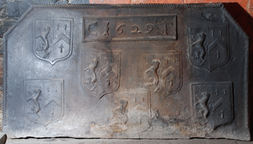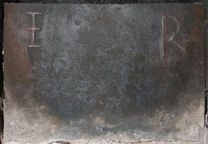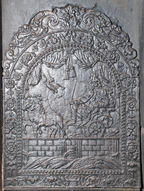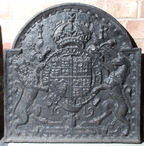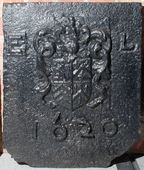-
28
Description: Rectangular with pediment raised on inverted consoles; ovolo, egg and dart edging; shield, garter, helm, mantling, crest and motto of the English House of Stuart; date split either side of garter buckle.
Notes: One of several firebacks, all of the same date, but varying in size, framing style and moulding; all have stylistic features in common and will have been the work of the same pattern maker, who was also responsible for carving royal coats of arms in three West Country churches.
Copies of this fireback are known.
Inscription: HONY SOIT QVI MAL Y PENSE / 16 18 / DIEV ET MON DROIT
Arms: English Stuart royal (James I)
- Decoration tags:
- rectangular with detached pediment (shape)
- ovolo, egg and dart (edging)
- whole carved pattern
- armorial
- royal
- text
Manufactured: in 1618 possibly in the Forest of Dean area of England.
Current location: Bateman's, Burwash, East Sussex, England.
Museum number: 761132 (part of the National Trust museum group)
-
29
Description: Rectangular; cavetto moulded edging; initials in top left corner; date in top right corner.
Notes: The style of lettering and numerals is reminiscent of those seen on firebacks associated with the Sidneys, Earls of Leicester, and may suggest a common source.
Inscription: IB 1695
- Decoration tags:
- rectangular (shape)
- cavetto (edging)
- individual letters
- individual numbers
- text
Manufactured: in 1695 possibly in the Weald area of England.
Current location: Bateman's, Burwash, East Sussex, England.
Museum number: 761128 (part of the National Trust museum group)
- Attached to series:
- Date & initials firebacks
-
30
Description: Rectangular, with canted top corners; twisted rope edging on top and sides; cavetto-moulded-edged rectangle top centre, enclosing date between initials; seven shields of Ayloffe impaling Sulyard; Ayloffe: sable, a lion rampant Or, collared gules, between three crosses formy of the second; Sulyard: argent, a chevron gules between three pheons inverted sable.
Notes: William Ayloffe (c.1535-1584) of Bretons, Hornchurch, Essex, Justice of the Court of Queen’s Bench, married (c1560) Jane, dau. of Sir Eustace Sulyard, of Runwell, Essex. A large number of variants use the same shields. The possibility that 'CT' was the founder Charles Tyler (d.1629/30) is reinforced by the fact that Poundsford Farm, Burwash, was owned by his grandson, also Charles, and subsequently by the latter's widow, Mary. The back was first noted at Poundsford in 1869.
Inscription: C 1629 T
Arms: Ayloffe impaling Sulyard (William Ayloffe of Bretons, Hornchurch)
- Decoration tags:
- rectangular with canted top corners (shape)
- rope (edging)
- carved stamps
- individual letters
- individual numbers
- planklines
- armorial
- text
Manufactured: in 1629 possibly at Hawkhurst Furnace in the Weald area of England.
Current location: Poundsford Farm, Burwash, East Sussex, England.
Citation: Gardner, J. S., 1898, 'Iron Casting in the Weald', Archaeologia, 56, 1, pp. 133-164.
Citation: Trower, C. F., 1869, 'Burwash', Sussex Archaeological Collections, 21, p. 113.
- Attached to series:
- Ayloffe series
- Personal armorial firebacks
-
621
Description: Rectangular; ovolo moulded edging (top and sides); central shield, crest and mantling of the Fuller family. The date, of which the 1 is not visible, is split between the top corners of the shield and about two-thirds of the way down.
Notes: A carved armorial on a plain, edged base board; the arms of the Fullers of Brightling Park, Sussex, are: Argent, three bars and a canton gules; the crest; Out of a ducal coronet Or, a lion’s head argent. The Fullers were iron masters and gun founders in the first half of the 18th century, operating Heathfield furnace, where it is likely that this fireback was cast.
Copies of this fireback are known.
Inscription: [1] 7 / 4 7
Arms: Fuller, of Brightling, Sussex
- Decoration tags:
- rectangular (shape)
- ovolo (edging)
- carved pattern panels
- heraldic
- armorial
- text
Manufactured: in 1747 probably at Heathfield Furnace in the Weald area of England.
Current location: in private hands, Butleigh, Somerset, England.
- Attached to series:
- Ironmasters armorial series
- Personal armorial firebacks
-
221
Description: Rectangular; plain plate; inscription in capitals split between top corners, ‘I’ crossed.
Notes: The letters are likely to have been formed by tracing their shape in the casting sand using a pointed implement.
Inscription: I R
- Decoration tags:
- rectangular (shape)
- none (edging)
- individual letters
- text
Manufactured: in the early-17th century in the Weald area of England.
Current location: in private hands, Buxted, East Sussex, England.
- Attached to series:
- Initials only firebacks
-
222
Description: Arched rectangular central panel with ‘nutshell’ edging on a broad fillet; crowned figure, holding a sceptre in his right hand, sitting in a chariot drawn to the left by two horses with ostrich feather head-dresses; the whole upon a causeway with pilasters and masonry, and waves beneath; a heron flying to the left; above, swagged drapery with two tassels hanging from the centre; arched rectangular shaped border with fillet edging, symmetrical, flower bunches, descending from a ribbon loop; monogram centre bottom, between plant tendrils; on top, symmetrical scrolled plant tendrils.
Notes: The design is derived from a personification of Europe, one of a set of playing cards entitled 'Jeu de la Géographie', designed by Stefano della Bella (1677); a similarity with Queen Anne may not be coincidental; the flying heron has been copied from a print by Wenceslaus Hollar c.1658.
Copies of this fireback are known.
Inscription: SHR
- Decoration tags:
- 'Dutch' (shape)
- fillet (edging)
- whole carved pattern
- pictorial
- allegorical
- monogram
- text
- animals
- humans
- objects
Manufactured: in the late-17th to early-18th century in England.
Current location: Canons Ashby House, Canons Ashby, Northamptonshire, England.
Museum number: NT/L/CAN/M/79 (part of the National Trust museum group)
- Attached to series:
- SHR series
- British 'Dutch' style firebacks
-
223
Description: Rectangular; cavetto with double fillet edging; two side panels each separated by twisted rope, and each containing six fleurs de lys arranged vertically; top panel separated by twisted rope, containing inscription; central panel with lion’s head between two fleurs de lys.
Notes: A late example of the use of individual carved stamps; from Heol Ddu Isaf, Bargoed, acquired by the National Museum of Wales in 1922.
Inscription: WLA [triad] 1714 WLA [triad]
- Decoration tags:
- rectangular (shape)
- carved stamps
- individual letters
- individual numbers
- heraldic
- text
Manufactured: in 1714 possibly in the South Wales area of Wales.
Current location: National History Museum, St Fagans, Glamorgan, Wales.
Museum number: 21.31 (part of the Welsh National History Museum museum group)
- Attached to series:
- Miscellaneous stamp firebacks
-
226
Description: Arched rectangular shaped central panel with bead-and-pellet edging on a wide fillet; central pedestal with a wyvern fountain ringed with water, and a swan and a duck swimming, plants rising from the waves; above, swags of drapery with two central tassels; arched rectangular shaped border with fillet edging, symmetrical floral fronds descending from a rose, top centre, with a looped 'W' in each shoulder; inscription at base, between date; on top, symmetrical scrolled plant tendrils. A single vertical plankline right of centre.
Notes: One of a group of firebacks all of the same date, some of which have the same Welsh inscription which translates as 'God is our strength'. All incorporate the looped 'W' motif which may be intended to identify the pattern maker. The design is taken from 'Livres de Fontaines' by Daniel Marot (1661-1752) (La Haye & Amsterdam 1701). The swan and the duck swimming may have been copied from etchings or paintings by Francis Barlow (c.1624-1709), whose images of birds have been used incidentally on other firebacks. Formerly at Allt-y-ferin, Nantgaredig, Carmarthenshire.
Copies of this fireback are known.
Inscription: 17 DVW Ydyw Ein Cadernid 24
- Decoration tags:
- 'Dutch' (shape)
- fillet (edging)
- whole carved pattern
- planklines
- pictorial
- architectural
- text
- animals
- plants
- objects
Manufactured: in 1724 in England.
Current location: National History Museum, St Fagans, Glamorgan, Wales.
Museum number: 62.156 (part of the Welsh National History Museum museum group)
- Attached to series:
- 1724 series
- Welsh inscription series
- British 'Dutch' style firebacks
-
229
Description: Rectangular with superimposed arch; embattled, cavetto moulded edging, with the top edge of the rectangle interrupted; shield, garter, crown, supporters and motto of the English Royal house of Stuart; rose and thistle plants above lion and unicorn supporters respectively; initials split by crown; date below garter.
Notes: An example in the Musée d'Agen in France is illustrated by Carpentier (1912, p.419). A different version is at Newick Park, Sussex (no. 502).
Copies of this fireback are known.
Inscription: I R / HONI S OIT QVI MAL Y ..ENSE / 16 19
Arms: English Stuart royal
- Decoration tags:
- rectangular with round arch (shape)
- embattled cavetto (edging)
- whole carved pattern
- armorial
- royal
- text
Manufactured: in 1619 in England.
Current location: National History Museum, St Fagans, Glamorgan, Wales.
Museum number: 48.354/85 (part of the Welsh National History Museum museum group)
Citation: Carpentier, H., 1912, Plaques de Cheminées (Paris, published by the author).
-
232
Description: Rectangular shape with bottom corners missing; no edging; central shield, helm, crest and mantling of the Lewis family: quarterly 1st, sable a lion rampant argent (Lewis of Y Fan), 2nd, sable a chevron between three fleurs de lys or (Einon ap Collwyn), 3rd gules three chevronels argent(Iestyn ap Gwrgan), 4th, sable a chevron between three spear heads argent embrued gules (Bleddyn ap Maenyrch); initials split by armorial stamp (’E’ over-stamped); date, formed from single numerals, below arms.
Notes: The arms are those of Sir Edward Lewis, of Van, who purchased St Fagans Castle in 1616. The same armorial stamp was used to model the arms on a lead cistern outside the front door of the castle. It is possible that this fireback was cut down from a larger fireback.
Inscription: E L 1620
Arms: Sir Edward Lewis of Van
- Decoration tags:
- rectangular (shape)
- none (edging)
- carved stamps
- individual letters
- individual numbers
- armorial
- text
Manufactured: in 1620 in the South Wales area of Wales.
Current location: National History Museum, St Fagans, Glamorgan, Wales.
Museum number: 48.354/84 (part of the Welsh National History Museum museum group)
- Attached to series:
- Personal armorial firebacks
- Welsh armorial firebacks
- Bristol armorial group


